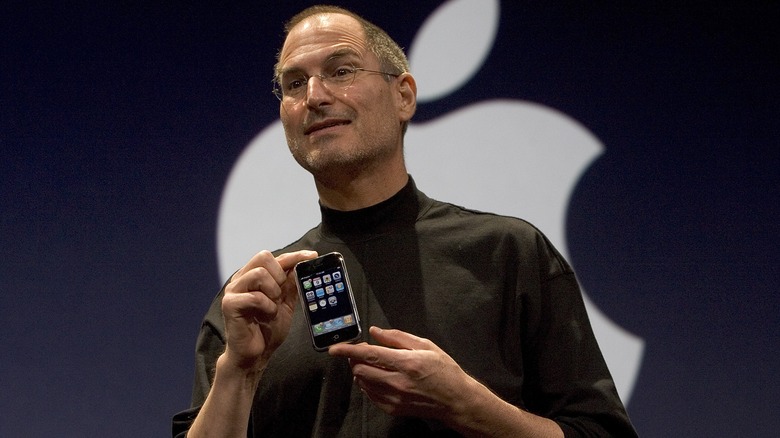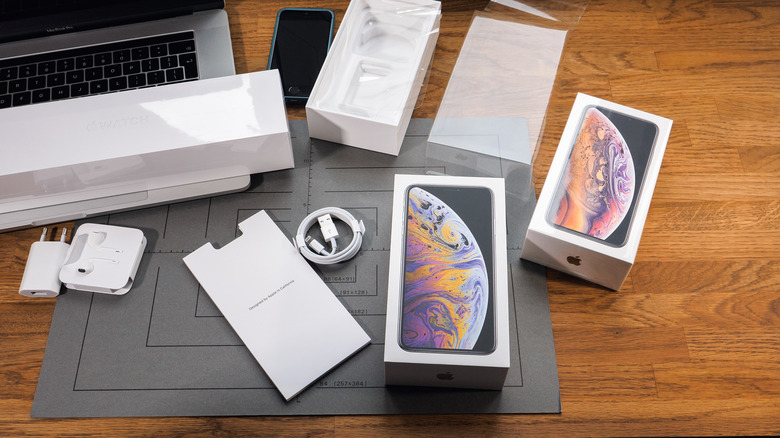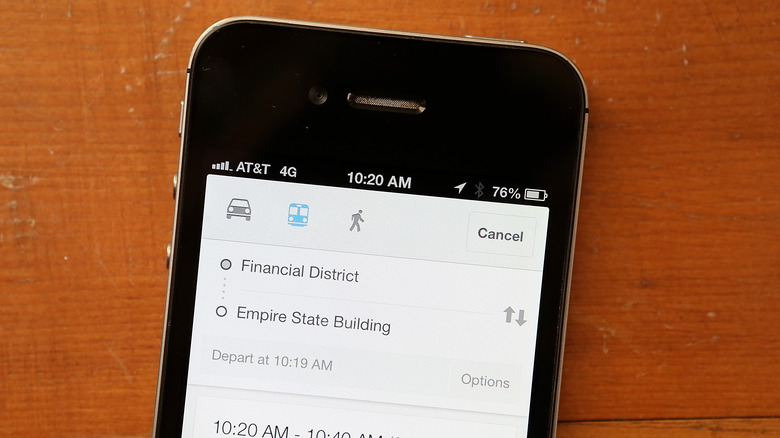

The 5 Best And 5 Worst Apple iPhones Of All Time
source link: https://www.slashgear.com/1081473/the-5-best-and-5-worst-apple-iphones-of-all-time/
Go to the source link to view the article. You can view the picture content, updated content and better typesetting reading experience. If the link is broken, please click the button below to view the snapshot at that time.

The 5 Best And 5 Worst Apple iPhones Of All Time

When Steve Jobs took the stage at Macworld in 2007, nobody could have predicted the effect the device he was about to announce would have. The iPhone wasn't the first touchscreen cellphone (via Bloomberg), but it had magic. There was genuine excitement in the air, and the iPhone sold like crazy when it hit the stores. It felt like the future. It turned out it was the future, with almost every smartphone made today having the same combination of touchscreen, apps, access to the internet, and a phone.
At the time, nobody outside of Apple knew how much the company had riding on the success of the iPhone. It was a "bet-the-company product," according to Apple's senior vice president of worldwide marketing, Phil Schiller. That bet paid off big, with Apple routinely in the top three worldwide companies in market capitalization (via Investopedia). The iPhone has gone through many reincarnations since that original device. Some were great, some not-so-great, but they all made the smartphone market what it is today.
How we chose the best (and the worst)

We'd love to say this is a purely objective, judged-on-individual-merits-alone list. It's nearly impossible to make any list of "The Best..." or "The Worst..." of anything without getting a bit subjective. That's just being human. Some designs call to us more than others. Sometimes it's the technological feats, how they changed culture, or how we use our phones. The high points were considered, but so were the low ones. Those iPhones that pushed portable communication forward, or those with issues that made the devices unfit for purpose.
The iPhone models on the best half of this list had to do something different to gain a place. They had to push design forward or sometimes take our breath away. They took risks. The phones in the latter half of this list may have pushed the industry forward, but only with their sheer numbers, not technologically. After all, Apple's sales figures speak for themselves (via Statista). These five had major issues, recycled more than just the materials used, or in one case, it was from before Apple got good at making phones.
iPhone 4S - Best

Ah, the iPhone 4S. My particular favorite is a beautiful medley of industrial design and blazing-fast hardware. It was the first iPhone with Siri and the last iPhone released before Apple's co-founder, Steve Jobs, passed away (via History.com). The iPhone 4S doesn't appear to be outwardly different from the iPhone 4, but we'll get to why that model ended up on the other section of this list later. It had the same 3.5-inch Retina Display, the same glass and aluminum casing, and the same industrial design. What it also had was power. The Apple A5 chip was the first dual-core processor in an iPhone.
That, and the tight integration with iOS, gave it spectacular speed. Apple said the iPhone 4S offered "twice the processing power of its predecessor, along with an impressive 7x the graphics abilities." That's an impressive mid-generational leap and gave app developers more power to play with. You wouldn't think about using an iPhone without Siri these days, but that's what it was like before this handset. Siri was fairly rudimentary in what she could do at launch, but it has had a decade of learning. This was also the first iPhone to feature iCloud, another Apple service we couldn't be without on our iPhones today. You no longer need to use iTunes to set up your iPhone 4S or to update iOS. Your Photo Stream synced to all your devices, and so did purchased music. You also had the nascent tracking and wiping functionality that would eventually become Find My.
Original iPhone, 3G, and 3GS - Best

The cellular market in the mid-2000s was full of feature phones, carrier-subsidized handsets, and slow mobile internet. And then the iPhone came along, bundling an iPod, a phone, and an internet browser in one pocketable device. In an instant, the face of pocketable computing changed. The cellular phone market changed. The iPod has already changed how we listen to music, but now you don't have to carry two devices around. Perhaps it's unfair to group all three of the first iPhones into one place on the list. Then again, they all had the same 3.5-inch glass touchscreen. They all functioned as an iPod, Apple's digital music player. They all connected to the internet and made phone calls. They were also very similar shapes, with the iPhone 3G and 3GS slimmer versions of the 2007 iPhone, so they'd fit better in users' hands.
The first iPhone might have changed the mobile phone form factor for good, but the second one changed how we use them. When the first iPhone came out, it had pre-installed Apple apps and some third-party apps but no App Store nor a way to add new apps. Then the iPhone 3G brought the App Store, faster 3G connectivity, and GPS tracking. Then the iPhone 3GS (S for speed) was another leap, doubling the RAM, improving battery life, and sporting iOS 3.0. Apple might not have succeeded without the rapid-fire changes in these three models. The rest, as they say, is history.
iPhone 6S and 6S Plus - Best

Critics might say that the "S" versions of all iPhones are only incremental improvements over the previous devices. The thing is, we prefer to think of that "S" as "Saved from ignominy." Two of the devices on our top five worst iPhones were saved by the "S" version. In this case, the iPhone 6 Plus' tendency to bend when put in your jeans pocket was saved by the iPhone 6S Plus. Apple didn't redo the design with the iPhone 6S and 6S Plus. It didn't need to; the sleek lines spoke volumes already. Almost everything they changed was under that satin aluminum exterior.
The alloy used for the body was upgraded to the same 7000-series aerospace-grade aluminum used in the Apple Watch. This made even the larger iPhone 6S Plus less prone to bending. Apple changed the glass to tougher material and made the Touch ID sensor register your fingerprints faster. The rear camera was upgraded to 12 megapixels from the 8-megapixel sensor used on the iPhone 6. That enabled 4K video recording for the first time. Live Photos made their first appearance — those little animated clips we all love now. Apple introduced the A9 chipset in this generation, with a 70% boost in CPU and a 90% boost in GPU over the iPhone 6's chipset (via Apple). The last innovation introduced on the iPhone 6S and 6S Plus was 3D Touch, that handy long-press that gave you haptic feedback and triggered new menu options.
iPhone X - Best
Apple had a problem with the iPhone X. They wanted to put many sensors into the front to power Face ID, their new facial recognition biometric system. That would have meant a larger-than-usual top bezel, but Apple took a brave new design decision instead. The display notch was born. A blacked-out section with all the new sensors, cameras, and microphones was cut into the top edge of the new OLED screen. This gave Apple enough space for an infrared camera, a flood illuminator, a proximity sensor, an ambient light sensor, a speaker, a microphone, a front camera, and a dot projector.
Face ID is still the best facial biometric system, even with the necessary but controversial notch. The reason it's so good is because of the TrueDepth camera. It scans your face with thousands of invisible dots to create a depth map (via Apple). This means it can't be fooled by a picture or a video recording, unlike other facial recognition systems. Because of Face ID, the Touch ID home button could be removed. That left lots of space for Apple to stretch the OLED screen right to the edges, and they did just that. It also meant Apple needed a new way for users to navigate the screen, creating a gesture-based system. It took until the iPhone 12 for Apple to change the design language laid down by the iPhone X.
iPhone 14 Pro and Pro Max - Best
The notch screen design laid down by the iPhone X changed with the iPhone 14 Pro and iPhone 14 Pro Max. Apple introduced the Dynamic Island. This screen area surrounds the cameras and Face ID sensors and changes to show notifications and other important information. Speaking of changes (at least in the U.S.) the iPhone 14 Pro and Pro Max debuted with eSIM only. There is no SIM tray in the U.S. versions of the iPhone 14 Pro or any other iPhone 14 model. Whether that helps with weatherproofing, we can't say, but it does improve the sleek lines of the sides. For the first time, you also get satellite connectivity for emergency situations when you're out of cellular range. This lets you send messages to emergency personnel, even when you're out of service.
Apple also added crash detection, with your iPhone able to call emergency services on your behalf, in case you're unable to. That's the kind of feature all devices we carry daily should have. Apple also upgraded the cameras. Instead of the usual 12-megapixel wide camera, a new 48-megapixel wide camera is used. This gives crisper images, which we felt "reflect a more accurate representation of the conditions" in our testing. Keeping on with the technological advances, the Pro models feature Apple's latest A16 Bionic chip. This supremely fast chip scored 50% higher in Geekbench than Qualcomm's latest processor running in Samsung's Galaxy Z Flip 4.
iPhone 5C - Worst

The iPhone 5C was Apple's only return to a plastic housing since the iPhone 3GS, and it was also the first and only time Apple took a "lesser than" approach to make an iPhone. It came in neon colors, pink, yellow, blue, green, and a dazzling white. To offset the flexibility of the polycarbonate shell, Apple used a steel frame, which also doubled as the antenna. Apple kept the internal hardware the same as the outgoing iPhone 5 flagship. We couldn't say if that happened due to oversupply or internal strategies. We can say that reusing the internals and giving them a lower price paved the way for the iPhone SE range.
The pricing didn't make sense, with only a $100 difference from the iPhone 5, which shared many components. A hundred dollars to have a bright, colorful plastic shell instead of a sturdy aluminum enclosure. This entry is more subjective than the rest, but there's just something about Apple selling a plastic, technically-inferior device that is irritating to see. Maybe that's why it was the last plastic-enclosed iPhone that Apple created.
iPhone 4 - Worst
Apple launched the iPhone 4 in 2010 to round-the-block queues and rave reviews. We called it "one of the most polished, appealing smartphones on the market today," and we still stand by that. The looks, the camera, and the power of the iPhone 4 aren't the reasons it's on the "worst" part of this list. Without one glaring issue, this would have been one of the best iPhones ever, and deservedly so. Then "Antennagate" happened. For the first time, Apple put the cellular antenna on the external casing, as this was the first metal-covered iPhone, and it provided an opportunity for boosting signal strength.
Once the iPhone 4 got into users' hands, nobody noticed boosted signal strength. Instead, holding the iPhone in your left hand bridged the device's two antennas, reducing the cellular signal. Consumer Reports (CR) confirmed this, testing the iPhone 4 and offering temporary solutions like covering the gap with duct tape so you couldn't touch the metal. Failing the tests mean that CR gave a rare "we can't recommend the iPhone 4." Then Apple mishandled the response, with then-CEO Steve Jobs sending out an email with "just avoid holding it in that way (via CNN)." Blaming the users for a design decision is never a good look, even if Jobs did offer every iPhone 4 owner a free case to cover up the antenna. Two years later, Apple settled a class-action lawsuit over the issue, with buyers getting either $15 or a free iPhone 4 case.
iPhone SE - Worst
In 2016, Apple tried again with a lower-cost iPhone, but it used the premium materials from previous models this time. The iPhone SE was born, a Franken-iPhone bolted together from the parts bin. Apple used the iPhone 5S's design, the A9 chipset from the iPhone 6S with 2GB of memory, and the 12-megapixel camera from the iPhone 6S. For $399, you got most of an iPhone 6S for two-thirds of the cost, stuffed into an obsolete chassis. That's the point. It's what makes the iPhone SE terrible, whether that's the first-gen, second-gen, or third-gen.
The iPhone should be about pushing boundaries, making fantastic technology ubiquitous, giving you a reason to upgrade. The iPhone SE range is none of these things. The second-gen iPhone SE got the iPhone 8's design, with the iPhone 11's A13 Bionic chip under the hood. After so many years of iPhones using an edge-to-edge screen and gesture navigation, Touch ID and a physical home button meant unlearning muscle memory. The current iPhone SE is powered by the A15 Bionic used in the iPhone 13 range but used the iPhone 8's design and dimensions. The iPhone 8 came out in 2017. That's a long time in the smartphone market. Apple should recycle metals, plastics, and glass. But it should please stop recycling designs.
iPhone 6 Plus - Worst
The iPhone 6 and 6 Plus were notable for Apple's most significant departure into a new design language to date, but that paled against another device-destroying design defect. Named "Bendgate," multiple reports of iPhone 6 models bending while in pockets came shortly after the retail launch. Apple designed the iPhone 6 and 6 Plus with aluminum for the housing and internal frame. New features like Apple Pay, the Health App, and Family Sharing made them more usable in real life. They had curved, sleek sides, were "drastically thinner than the previous models," and had larger screens. Ultimately, the slim aluminum design was to be its downfall.
Users reported that having their iPhone 6 in their jeans pocket made the aluminum bend. All the affected devices seemed to bend in the same place, near the volume buttons. Apple tried to say that only nine customers had contacted them during the first six days after the iPhone 6 went on sale. In court documents, we found out years later that Apple knew there was an issue before sales started, with the iPhone 6 and 6 Plus being "much more likely to bend than the iPhone 5s they replaced." The internal documents showed that the iPhone 6 and the iPhone 6 Plus were 3.3 times, and 7.2 times more likely to bend than the iPhone 5S.
Rokr E1 - Worst
You might wonder how a phone without the "iPhone" moniker makes its way onto the worst section of this list. The reason is that this was the first phone that could sync with iTunes. That sounds like a nascent iPhone, even if the Rokr E1 was built by Motorola. The candy bar phone wasn't even a smartphone; that didn't happen until the first iPhone. It could play your iTunes library at a time when digital music was taking off. Well, you could play part of your library anyway, as it could only transfer 100 songs at a time from iTunes (via Apple).
What's terrible about this phone wasn't that it had to compete with Sony Ericsson's walkman phones. Also, the low storage could only be expanded by expensive storage cards. Add to that, Steve Jobs flubbed the stage presentation by hitting the wrong button, so it didn't play music as it was supposed to. But what was really terrible about this phone is that Apple seemingly sabotaged it. Designed to undercut potential rivals to the iPod by putting an iTunes-equipped phone into the world, Apple decided to launch it at the same event that it launched the iPod Nano. The iPod Nano's promise of 1,000 songs in your pocket blew away any chances the Rokr E1 had of success. A year later, Apple ended support for the Rokr E1 (via CultofMac), while creating the iPhone in the utmost secrecy.
Recommend
About Joyk
Aggregate valuable and interesting links.
Joyk means Joy of geeK





